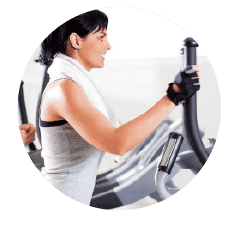Rehab Injuries With An Elliptical Machine
While rest used to be the main prescription for knee injuries, these days, most athletes are turning to dynamic rest. Rather than going from all to nothing, a modified plan of movement is the best way to keep your emotional and physical state up. According to a recent study, “if you’re all of a sudden injured and can’t work out every day, you’re experiencing a major dip in endorphins. Plus, with your brain producing less of these feel-good chemicals, the negative emotions surrounding your injury become harder to manage.” The solution? Staying in tune with your body and knowing how and when to modify. If you’re able to get a low-impact workout in, we highly recommend the elliptical machine. Why? The elliptical machine mimics walking perfectly with no ground impact at all. Jillian Michaels explains, “Most weight bearing activities, such as walking or running, cause wear and stress on your joints. Elliptical machines offer a no-impact alternative to these activities. Your feet never have to leave the pedals. This aspect of elliptical workouts make them much easier on the joints, particularly the knees and hips.” The natural oval movement of the machine is key because it ensures that your hips, knees, and ankles stay properly aligned, preventing more wear and tear on your body. And, because many knee injuries are a result of weak quads, a daily low-impact activity (like working out on the elliptical) will help to strengthen those muscles and whip you back into shape in no time.
So, why choose the elliptical machine over a standard treadmill to rehab an injury? According to the Mayo Clinic:
- Using an elliptical machine can be less stressful on your knees, hips, and back than running on a treadmill.
- Unlike treadmills, some elliptical machines are equipped with moveable upper body handles or poles, similar to ski poles. These allow you to exercise both your arms and your legs.
- Most elliptical machines can be pedaled in reverse, which allows you to work your calf and hamstring muscles better than if you were to move in a forward motion.
To maximize your elliptical workout and help heal your body, follow these tips:
- Never adapt your posture or position to fit the equipment. An elliptical should simulate natural movements like walking or running and if you’re trying to move yourself around to fit the machine, you’re likely to become injured again.
- The optimal elliptical stride length is 19.5-20.5 inches – most elliptical brands offer stride adjustments, so be sure to correct your stride length to move properly.
- Opt for a machine with close pedal spacing. The wider the space between the pedals, the more likely it is for a user’s hips to shift laterally, ultimately leading to back pain, leg pain, and more injury.
- Pay attention to the pace of the pedals. When you pedal up and down, you engage the muscles in your feet and ankles, and if your movements are excessive, it can limit knee and hip extension.
- Unlike many other stationary fitness machines, the elliptical synchronizes arm and leg movements. This means that as you move, you’ll be simulating natural shoulder and arm extensions.
All in all, it is apparent that elliptical trainers are the best choice for injured knees (and other ailments as well). With an elliptical, there is no knee rotation involved, therefore, there is no strain on the knee because the machine works in a swinging (oval-like) movement. If you do experience pain on the elliptical machine, it will most likely be the result of poor form rather than an issue with the workout or machine itself. Like any new workout, be sure to consult a doctor to ensure what you’re doing is right for you and your personal injury.
Have you tried treating an ailment on an elliptical machine? If so, we’d love to hear about your results!



 Compact/Folding
Compact/Folding Front Drive
Front Drive Rear Drive
Rear Drive